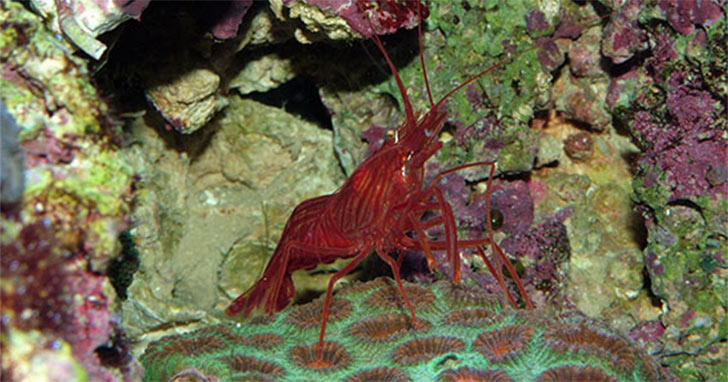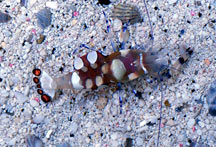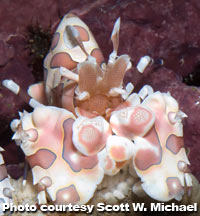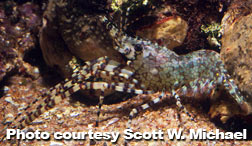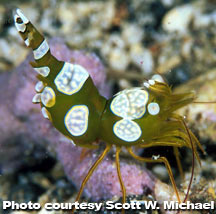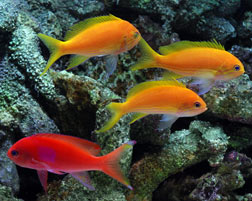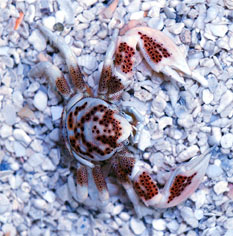Aquarium Shrimps - Shrimp Care
By Scott W. Michael
Most of the shrimps available to aquarists are relatively easy to keep if they are placed in the right captive venue. They should be provided with suitable shelter, but the type of shelter depends on the species in question. For example, most of the reef-dwelling forms simply need crevices or overhangs to lurk in or under. In contrast, most of the snapping shrimps encountered in the trade, prefer a sand bottom so that they can dig burrows. You can facilitate burrow construction by adding pieces of rubble or by placing flat rocks on the sand surface that act as a ceiling for their subterranean homes.
Aquarium size is less of a factor for shrimps than it is for fishes. Most of the shrimps can be kept in tanks as small as 2 to 5 gallons. The majority of species available in the aquarium trade are quite small and do not need a large home range in which to roam. For example, many of the cleaner shrimps stay within the same crevice or cave for most of their lives. Some species are best displayed in smaller tanks. For example, a pair of Harlequin Shrimp in a 5 to 10 gallon tank makes a fantastic exhibit. If you place some of the smaller shrimps in a large reef aquarium, you may never see them again. They may hide constantly in the many caves and crevices present, or they may end-up being food for some cryptic predator (e.g., larger snapping shrimp, mantis shrimp) that came in with the live rock.
Feeding When it comes to feeding, the highly specialized Harlequin Shrimps (Hymenocera spp.) are a notable exception to the rule. These shrimps only feed on sea stars and will need a ready supply of these echinoderms if they are going to survive in the aquarium. A medium-sized sea star should last a pair of Harlequin Shrimp about one week. Make sure you remove the uneaten portions of the sea star so that it does not pollute the aquarium. Many of the Bumblebee Shrimps (Gnathophyllum spp.) also have specialized diets. While echinoderm tube feet may be eaten in the wild, at least some of these shrimps will accept frozen food in captivity.
Most of the shrimps available to hobbyists need relatively clean, well-oxygenated water. Shrimps tend to perish more readily during shipping if a shipment is delayed than other invertebrates or fishes because of oxygen deprivation. For example, the anemone shrimps in the family Palaemonidae are very sensitive to drops in oxygen levels and, as a result, often ship poorly. The aquarist should work quickly to acclimate these animals to holding aquariums so that they can be removed from shipping bags. Note that acclimation is very important for many shrimp species. If you expose them to drastic changes in temperature, oxygen levels, pH, or other water parameters, it is possible to shock them to death. "Drip acclimate" your shrimp for approximately one hour.
Unfortunately for crustaceans, there are predators that can smell chemicals produced during the molting process. Crabs and fishes will make short work of shrimps that have recently molted. (I once saw a large polychaete worm attack and swallow the chelae of a molting crab!) Not only is a molting shrimp more vulnerable to predators, it is also more vulnerable to attack from conspecific competitors. For example, boxer shrimps have been known to subdue conspecifics during or just after molting. Occasionally, a shrimp will die during molting because of the increase in energy expenditure and oxygen deprivation. This can happen if the shrimp has a difficult time getting out of its old armor. If a shrimp is having a difficult time shedding the old exoskeleton from one of its appendages, it may lose the problem leg, claw or antennae. However, when it molts again, it will regenerate the missing limb.
Some shrimps are more susceptible to attack than others. For example, the boxer shrimps (Stenopus spp.) are larger in general and have more formidable pincers than the anemone shrimps (Periclimenes spp.). Many of the species in the latter group are small, delicate shrimps that associate with other animals as a form of self-defense. Therefore, if you add a boxer shrimp to a tank that contains a large shrimp goby, it is not likely to bother it. However, if you add a small anemone shrimp to this same tank, the goby may eat it. When considering the potential danger they present to shrimps, fishes can be broken down into three major groups: those species that rarely if ever bother shrimps, those species that are potentially dangerous to shrimps, and those species that are always a threat to shrimp tankmates. The members of the rarely if ever bother shrimps group are obviously the species that make the best decapod companions. This group includes the anthias, small cardinalfishes, angelfishes, butterflyfishes, most damselfishes, flasher wrasses, small fairy wrasses, tube blennies, combtooth blennies, dragonets, smaller gobies, dartfishes, surgeonfishes and rabbitfishes. These fishes can be classified as herbivores, sessile invertebrate feeders and microcarnivores. The potentially dangerous to shrimps group is a mixed bag. These fishes tend to be more of a threat to smaller, more delicate shrimp species. Larger dottybacks, especially members of the genera Ogilbyina and Labracinus are dangerous to shrimps, while the smaller members of the pseudochromoid clan are usually not a threat to ornamental crustaceans. This applies to cardinalfishes as well. Larger apogonids are a threat to shrimps they can swallow whole, while the more diminutive cardinalfishes are usually good shrimp tankmates. Although many of the gobies are ideal shrimp tankmates, some of the larger species (e.g., Cryptocentrus) will ingest smaller shrimps. With members of this second group, adding the shrimp to the aquarium and letting it fully acclimate before you add the questionable fish species will help increase the shrimp's chances of survival. A stressed, flighty shrimp that has been dropped into a tank full of fish is a more attractive target than one that was there to begin with. The fishes that are always a threat to shrimp include: the sharks, rays, morays, snake eels, coral catfishes, lizardfishes, toadfishes, frogfishes, squirrelfishes, scorpionfishes, waspfishes, groupers, comets, tilefishes, hawkfishes, snappers, goatfishes, larger wrasses, large jawfishes, sand perches, triggerfishes, puffers and porcupinefishes. The only species of shrimps that may survive in a tank with these fishes are the cleaner species. For example, if a cleaner shrimp species is introduced to an aquarium before a moray is added, the moray may "tolerate" the shrimp and not eat it. (I should point out, that keeping a cleaner shrimp with a moray makes for an amazing and educational display!)
Compatible Invertebrate Tankmates Sea anemones are also potential shrimp predators. While there are some that can live among the stinging tentacles of these cnidarians, others will be stung and eaten. The Carpet Sea Anemones (Stichodactyla spp.) are the most dangerous. I have had cleaner (Lysmata spp.) and Marbled Shrimps (Saron spp.) dart about the aquarium and run into these toxic anemones when they were released into the tank. They were subdued and subsequently eaten. On one occasion, I had a large Clark's Anemonefish (Amphiprion clarkii) grab a marbled shrimp in its mouth and stuff it into its host carpet anemone! Some of the larger corallimorpharians, a close relative of the sea anemones, might also prey on shrimps. This includes the Elephant Ear Mushroom Anemone (Amplexidiscus fenestrafer) and some of the Rhodactis spp. Many of the shrimps can be kept in pairs or in groups, while others are less tolerant of conspecifics, especially members of their own sex. For example, the Camel Shrimp is usually seen in large aggregations in the wild and can be housed in groups in the aquarium. Likewise, the Skunk Cleaner Shrimp (Lysmata amboinensis) is found in groups and will tolerate each other in the confines of the aquarium. But the related Blood Red Shrimp (Lysmata debelius) is more aggressive toward conspecifics and is best kept singly, or (a male-female pair can be housed together). The boxer shrimps (Stenopus spp.) can also be very aggressive toward members of their own kind. So, while these shrimps can be housed in male-female pairs (which are often available from LiveAquaria.com), they should not be kept with consexuals. Heterospecific Stenopus spp. are also likely to quarrel and may attack and kill smaller shrimps in smaller aquariums. Male Marbled (Saron spp.) and possible some of the larger hingebeak shrimps (Rhynchocinetes spp.) will spar, especially in tight confines. Fortunately, members of both of the latter genera are sexually dimorphic, with the males processing elongated chelae. Keep only one male of these species in the same tank, unless it is very large so that males may be able to avoid each other.
While some of the shrimps are wonderful reef tank inhabitants, others are best avoided. There are some species that will feed on corals and their relatives. The hingebeak shrimps will feed on mushroom anemones, zoanthids, leather corals, and possibly other soft coral species, while the members of the genus Saron have also been reported to graze on soft and stony coral polyps, mushroom anemones, zoanthids and tridacnid clams. In conclusion, while the shrimps will not fit into every aquarium community, there are many species that are well-suited for either the fish or reef aquarium. Just remember to select their tankmates carefully and pick shrimps that will fit into your particular aquarium environment. Happy shrimp-keeping!
 Scott Michael
Scott MichaelScott W. Michael is an internationally-recognized writer, underwater photographer, and marine biology researcher specializing in reef fishes, and was the Banquet Speaker at our 2007 and 2008 Coral Conference and Frag Swap. He is a regular contributor to Aquarium Fish Magazine, Freshwater and Marine Aquarium Magazine, SeaScope, and is the author of Reef Fishes Vol 1, Vol 2, and Vol 3, Vol 4, and Vol 5., A Pocket Expert Guide Marine Fishes, A Pocket Expert Guide to Reef Aquarium Fishes, 101 Best Saltwater Fishes: How to Choose and Keep Hardy, Brilliant, Fascinating Species That Will Thrive in Your Home Aquarium, Reef Sharks & Rays of the World, and Aquarium Sharks & Rays. Having studied marine biology at the University of Nebraska, Scott has served as a scientific consultant for National Geographic Explorer, the Discovery Channel, and French educational television. Resources Debelius, H. 1999. Crustacea Guide of the World. IKAN, Frankfurt, Germany, 321 Pp. Fossa, S. A. and A. J. Nilsen. 2000. The Modern Reef Aquarium. Volume 3. Birgit Schmettkamp Verlag, Bornheim, Germany, 448 Pp. Hoover, J. P. Hawaii's Sea Creatures. Mutual Publishing, Honolulu, Hawaii, 366 Pp. |
||||||
|
|


